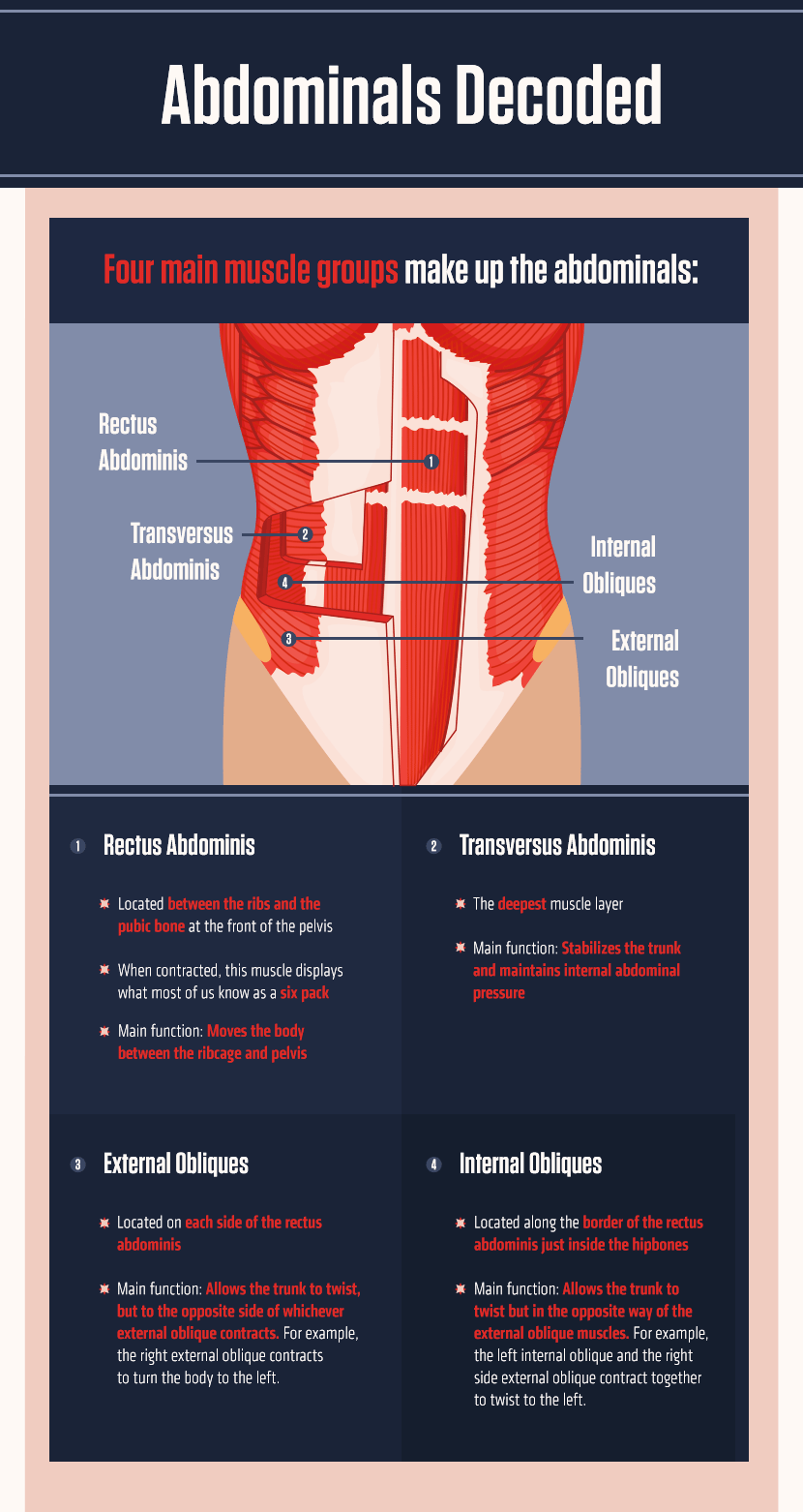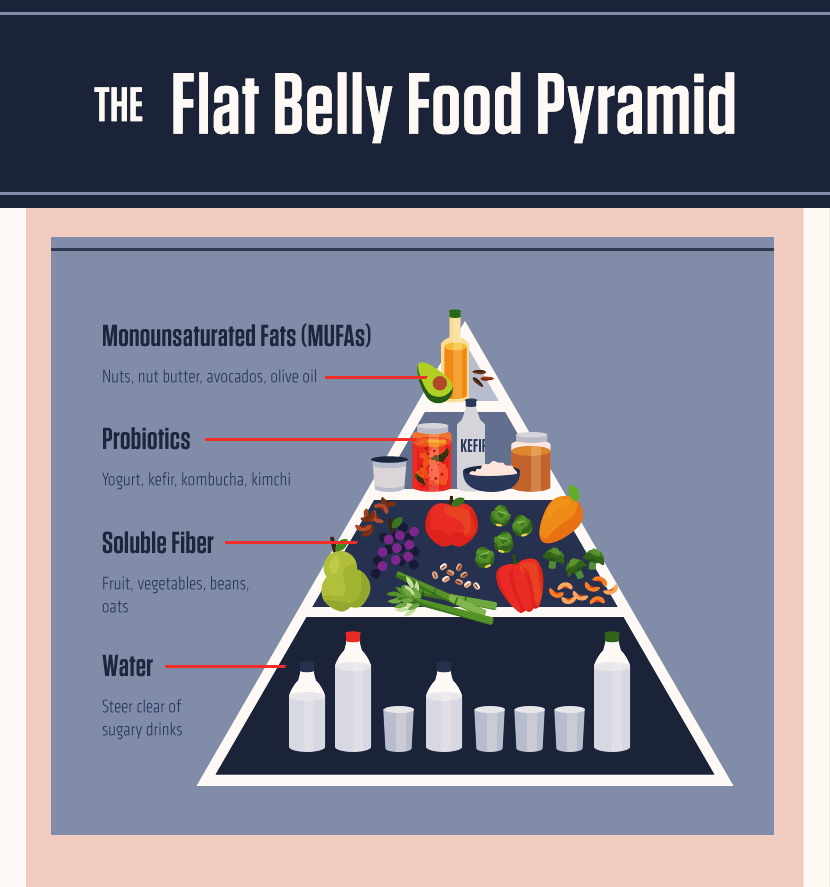Are Abs Really Sculpted in the Kitchen?
Whether your goal is washboard abs, a six-pack, or just for your clothes to lay a little flatter on your stomach, the path to a trim and fit midsection is the same. But are mega amounts of crunches the answer? Read on to find out how food and exercise contribute to abdominal muscles.
The First Step to Flatter Abs
Toning abdominal muscles is just one part of the equation. The other? Tackle what’s on top of that underlying six-pack. Men and women of all sizes typically have a layer of fat over their midsection. For abs to show through, the first step is to decrease body fat by burning more calories than you consume. There are two ways to achieve that: Exercise and reduced caloric intake. That’s where the phrase, “Abs are sculpted in the kitchen” gets its merit.
Burn, Baby Burn
The best way to burn calories is to raise your heart rate – in most cases, that means moving your body briskly. It doesn't matter what you do or when you do it, as long as you’re moving and it’s brisk.
Some examples of appropriate activities include:
- Walking
- Running
- Biking
- Dancing
- Stair-climbing
- Hula-hooping
- Jumping rope
- Vacuuming
You can choose the same activity every day, or change it up. Most of these can be done at home, but if you're a gym rat, cardiovascular machines including the elliptical, treadmill, stair machine, and rowing machine are perfect options as well. Shoot for 30 minutes of exercise per day. If you're already active for 30 minutes a day, up it to 45 minutes to work toward your ab goal.
Getting adequate cardiovascular activity doesn't have to be as daunting as it may seem and workouts don’t have to be completed all at once. If two 15-minute or three 10-minute bouts fit your day better, then do it. It can be good to change things up a bit to prevent boredom, but keeping it simple can get the job done. In fact, just walking has been shown to decrease belly fat.http://www.ncbi.nlm.nih.gov/pmc/articles/PMC4241903/
Time to Tone

As mentioned, targeted ab exercises can only do so much on their own. But while you whittle away some of the excess fat, you can tone the muscles underneath. So are the ever-popular sit-ups or crunches the best method? If so, how many and how often? If not, what is the best move for a killer core?
First, it may be helpful to get an idea of what abs really look like. The abdominals are actually made up four different muscle groups that work together to shape the entire midsection. To get the abs you long for, make sure you exercise each muscle group.
In the past, sit-ups were always the go-to abdominal exercise. But research suggests this crunching motion may not be the best choice, due to the stress and risk of injury put on the spine and neck. So what about all those infomercial machines that promise rock-hard, flat abs: Are they worth it?
Researchers have studied which exercises activate ab muscles the most. About a dozen years ago, a study sponsored by the American Council on Exercise compared 13 of the most common abdominal exercises, with some that used bodyweight only and others that used equipment (such as the Ab Roller and Ab Rocker).https://www.acefitness.org/about-ace/press-room/246/american-council-on-exercise-ace-sponsored-study They ranked the exercises in order of how effectively they strengthened the rectus abdominus (the big muscle down the middle) and the obliques (the muscles on the sides that form the waist).
The top two exercises for both muscle groups were:
The third best for rectus abdominus was crunches on an exercise ball, and reverse crunches for obliques.
More recently, a study in the American College of Sports Medicine's Health & Fitness Journal revisited the same question, but updated the research by including activities that are more popular, such as yoga and Pilates. They also looked at deep muscle activity. Deep muscles are often referred to as the core and are important because they support the spine and lower body.
The top three deep muscle exercises were:
- Pilates double leg stretch
- Dynamic side bridge
- Isometric side bridge
The top three oblique exercises were:
- The yoga boat
- The yoga dolphin plank on a ball
- The yoga side plank

You can pick two or three of these exercises and do them for 10 minutes or so one day. The next day, pick two or three different ones. Keep in mind that no matter which exercises you choose, you should take your time, move slowly and deliberately, and concentrate on engaging your abdominal muscles. Rushing tends to incorporate other muscles as well as momentum to complete the move, thereby reducing the effectiveness of the activity on your abs. Before you start any exercise, warm up your muscles with some gentle stretching and walking in place for a few minutes.
You Are What You Eat

An important part of getting fit and healthy is a healthy diet. To decrease any body fat that may overlay your abdominal muscles, you may choose to take in fewer calories than your body uses. But your body needs a bottom line amount of calories to function and to provide the energy needed to stay active. Here's a great tool to determine your daily calorie needs.
While it’s good to have a general idea of how many calories you need each day, don't think you need to become obsessed with calorie counting. Focus on eating mainly moderate portions of whole grains, lean proteins, fruits, vegetables, and low-fat dairy foods most of the time. Limit your intake of processed, sugary foods and drinks and high-salt and high-fat snack foods, and reduce large portions.
Everyone’s different, but here's a rough idea of how many servings of each food group you should eat:
- Grains: 6 to 8
- Fruit: 2 to 4
- Vegetables: 3 to 5
- Low-fat Dairy: 3
- Lean Protein: 4 to 6
You can find more specifics of what you need as well as examples of what counts as a serving from each group at ChooseMyPlate.gov.
In addition to a basic healthy diet, there are specific foods that have been associated with less belly fat and decreased bloating.
- Monounsaturated Fats (MUFAs): Diets high in MUFAs have been linked to less belly fat accumulation. These include nuts, nut butter, avocados, and olive and canola oils. These are sources of healthy fats, but they are high in calories, so don't go overboard in your portion sizes.
- Probiotics: The types of probiotics found in yogurts with live, active cultures have shown to help reduce bloating.http://www.ncbi.nlm.nih.gov/pmc/articles/PMC4202369/
- Water:Sugary drinks are usually nutritionally lacking but calorie-dense. Water is a great way to get the fluids you need and help prevent constipation, which can cause bloating. Plus, carbonation can trap tiny gas bubbles in your belly, which also contribute to bloating. For that reason, tap or fizz-free bottled water are better drink choices. Go ahead and flavor your water with cucumber or fruit if you prefer.
- Soluble Fiber: Soluble fiber is the type found in fruit, beans, and nuts. Studies show that eating more soluble fiber can help decrease the buildup of belly fat.http://www.highbeam.com/doc/1G1-269438339.html
- Sodium: This is one to limit, not increase. Sodium can cause water retention or bloating around your middle and other parts of the body. Aim to take in no more than 2400 milligrams per day.
Getting flatter abs is certainly an achievable goal. But you can't get them just by doing hundreds of crunches a day. The good news is that you can work toward your goal with a few simple exercises and a healthy, balanced diet.
Embed the article on your site

